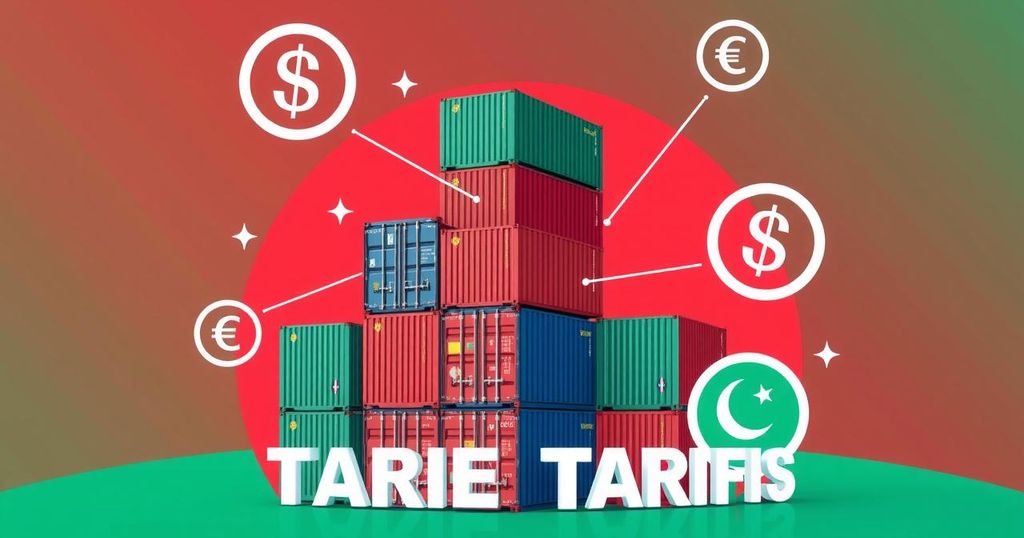Trump’s New Trade Policy: Implications of 37 Percent Tariff on Bangladesh
On April 2, 2025, President Trump announced a new trade policy imposing tariffs ranging from 10 to 50 percent on countries with high trade barriers against the U.S. Notably, Bangladesh will face a 37 percent tariff, significantly impacting its economy. Critics warn of potential trade wars and repercussions for global supply chains, while the international community’s reaction will determine the future of U.S. trade relations.
On April 2, 2025, President Donald Trump introduced a significant new trade policy as part of his “Liberation Day” initiative, which reflects a fundamental shift in the United States’ global trade strategy. In a provocative speech delivered from the White House Rose Garden, he criticized long-standing trade practices and asserted the need for American economic sovereignty through reciprocal tariffs, impacting nations including Bangladesh, China, and the European Union.
The crux of Trump’s trade policy hinges on reciprocity; if another country imposes high tariffs on American goods, the U.S. will respond with similar tariffs on that country’s imports. He declared April 2 a “day of economic independence,” emphasizing the need to address what he perceives as unfair trade practices that have harmed American workers and businesses, which he claimed have been “ripped off” by previous trade agreements.
Under this new policy, tariffs will range from 10 to 50 percent based on the trade barriers imposed by each country on U.S. exports. The European Union will incur a 20 percent tariff, China will face a 34 percent tariff, while Japan will see a 24 percent levy. Notably, Bangladesh’s imports will be subjected to a substantial 37 percent tariff, responding to the 74 percent tariff that Bangladesh imposes on American goods.
The increased tariff on Bangladesh, up from a previous rate of 15 percent, poses a serious threat to its economy, particularly impacting the garment sector, which constitutes over 80 percent of Bangladesh’s U.S. exports. As the competitive edge of Bangladeshi garments diminishes, industry leaders express concern regarding possible job losses and stunted economic growth amid increasing global competition, further alarming economists about potential global supply chain destabilization.
Other nations will also endure significant tariffs under this new trade policy. India will face a 26 percent reciprocal tariff due to its alleged 52 percent barriers on U.S. goods, while Pakistan will experience a 29 percent tariff in response to its 58 percent tariff on American imports. These measures threaten the textile and garment sectors of both countries.
The European Union, a longtime partner, will face a less severe 20 percent tariff, yet this may strain relations and impact ongoing trade discussions. For China, the imposed 34 percent tariff represents an escalation in the ongoing trade conflict, with potential countermeasures threatening to disrupt global economic stability following the COVID-19 pandemic.
Critics of Trump’s tariff measures argue that such retaliatory tariffs might lead to a trade war, raising costs for U.S. businesses and consumers. Companies dependent on imports for raw materials and goods could incur higher production costs, which may be transferred to American consumers.
Small businesses are particularly vulnerable, as reliance on affordable imports could diminish profit margins, affecting competitiveness. The comprehensive nature of these tariffs risks disturbing global supply chains, impacting industries that rely on international trade.
Trump’s tariffs under the “Liberation Day” initiative mark a pivotal change in U.S. trade policy with an emphasis on reciprocity. While aimed at safeguarding American jobs, the broader implications for global trade remain uncertain, particularly for nations like Bangladesh that could face severe economic repercussions. The international response will be crucial in determining if this marks a new era of protectionism or leads to a broader conflict with profound effects on the global economy.
President Trump’s recent implementation of a reciprocal tariff policy represents a significant shift in U.S. trade strategy, particularly impacting countries like Bangladesh. The tariffs, ranging up to 50 percent, aim to assert American economic power and address perceived trade imbalances. However, concerns regarding economic repercussions, particularly for vulnerable nations dependent on exports, raise questions about the potential for retaliation and a broader trade conflict. The international response to these tariffs will ultimately shape the future landscape of global trade relations and economic stability.
Original Source: weeklyblitz.net








Post Comment